Applying Theories & Models of Inclusive Learning Teaching & Assessment
VerifiedAdded on 2023/06/11
|22
|8850
|448
Essay
AI Summary
This essay provides a comprehensive analysis of inclusive learning, teaching, and assessment theories. It begins by examining various learning theories such as behaviorism, humanism, and cognitivism, alongside models like pedagogy and andragogy. It explores learning preference models like Kolb and Honey Mumford. The essay details how these theories and models can be applied in teaching, learning, and assessment, emphasizing the importance of individual learning preferences like visual, auditory, reading/writing, and kinesthetic styles. Furthermore, it delves into communication theories and their role in effective teaching, followed by an analysis of assessment principles and curriculum development models. The essay concludes by discussing reflection and evaluation theories and their application in reviewing teaching practices, highlighting the significance of these theoretical frameworks in enhancing the quality and inclusivity of education.
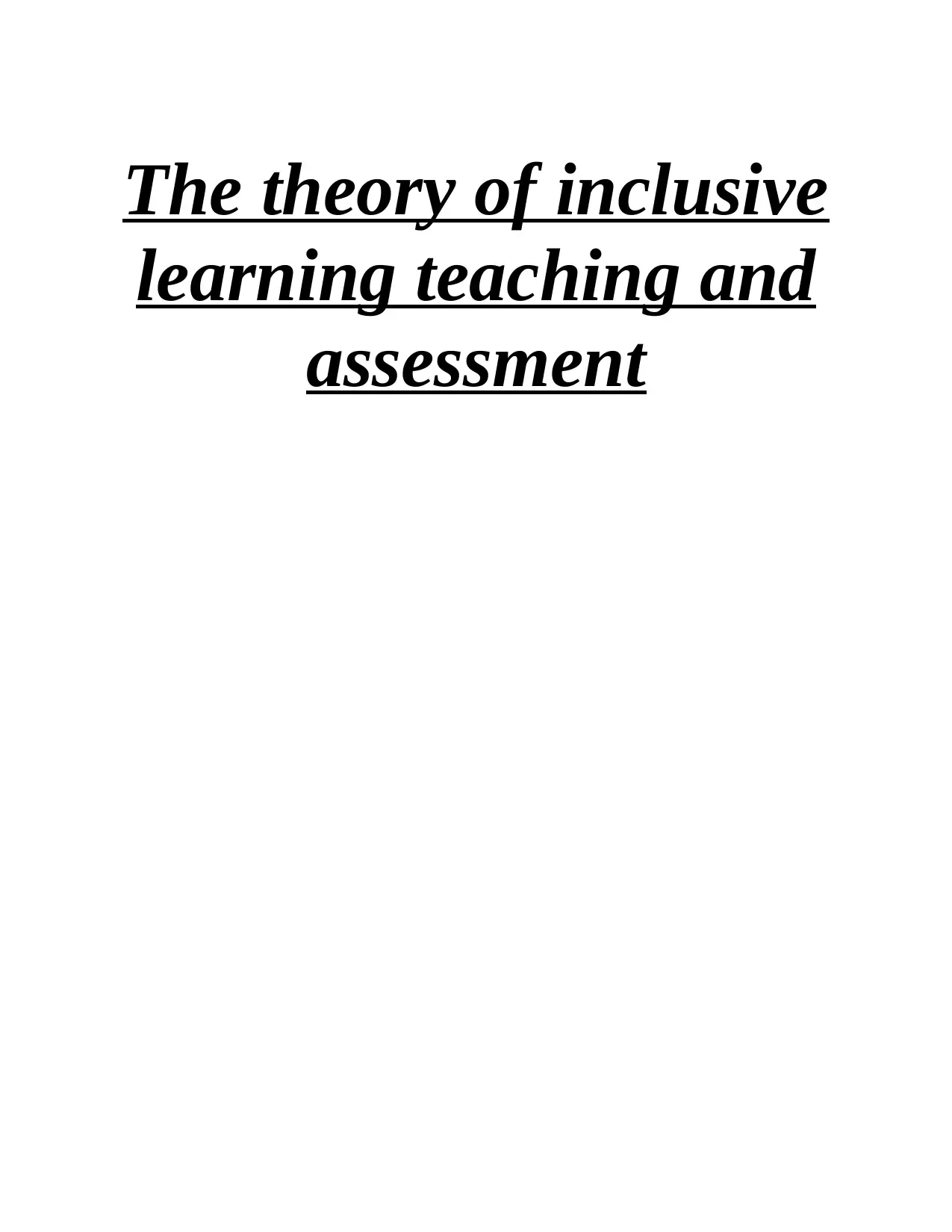
The theory of inclusive
learning teaching and
assessment
learning teaching and
assessment
Paraphrase This Document
Need a fresh take? Get an instant paraphrase of this document with our AI Paraphraser
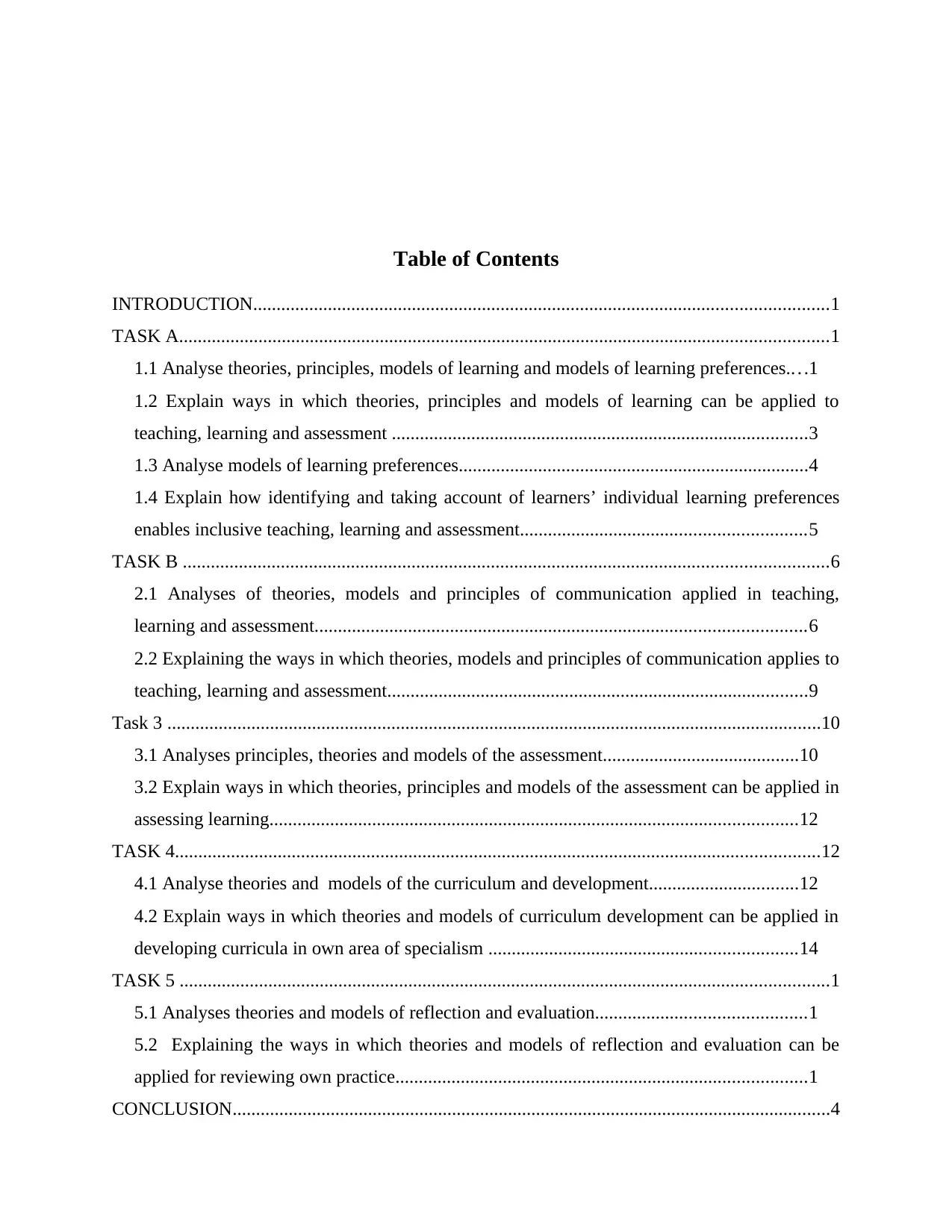
Table of Contents
INTRODUCTION...........................................................................................................................1
TASK A...........................................................................................................................................1
1.1 Analyse theories, principles, models of learning and models of learning preferences... .1
1.2 Explain ways in which theories, principles and models of learning can be applied to
teaching, learning and assessment .........................................................................................3
1.3 Analyse models of learning preferences...........................................................................4
1.4 Explain how identifying and taking account of learners’ individual learning preferences
enables inclusive teaching, learning and assessment.............................................................5
TASK B ..........................................................................................................................................6
2.1 Analyses of theories, models and principles of communication applied in teaching,
learning and assessment.........................................................................................................6
2.2 Explaining the ways in which theories, models and principles of communication applies to
teaching, learning and assessment..........................................................................................9
Task 3 ............................................................................................................................................10
3.1 Analyses principles, theories and models of the assessment..........................................10
3.2 Explain ways in which theories, principles and models of the assessment can be applied in
assessing learning.................................................................................................................12
TASK 4..........................................................................................................................................12
4.1 Analyse theories and models of the curriculum and development................................12
4.2 Explain ways in which theories and models of curriculum development can be applied in
developing curricula in own area of specialism ..................................................................14
TASK 5 ...........................................................................................................................................1
5.1 Analyses theories and models of reflection and evaluation.............................................1
5.2 Explaining the ways in which theories and models of reflection and evaluation can be
applied for reviewing own practice........................................................................................1
CONCLUSION................................................................................................................................4
INTRODUCTION...........................................................................................................................1
TASK A...........................................................................................................................................1
1.1 Analyse theories, principles, models of learning and models of learning preferences... .1
1.2 Explain ways in which theories, principles and models of learning can be applied to
teaching, learning and assessment .........................................................................................3
1.3 Analyse models of learning preferences...........................................................................4
1.4 Explain how identifying and taking account of learners’ individual learning preferences
enables inclusive teaching, learning and assessment.............................................................5
TASK B ..........................................................................................................................................6
2.1 Analyses of theories, models and principles of communication applied in teaching,
learning and assessment.........................................................................................................6
2.2 Explaining the ways in which theories, models and principles of communication applies to
teaching, learning and assessment..........................................................................................9
Task 3 ............................................................................................................................................10
3.1 Analyses principles, theories and models of the assessment..........................................10
3.2 Explain ways in which theories, principles and models of the assessment can be applied in
assessing learning.................................................................................................................12
TASK 4..........................................................................................................................................12
4.1 Analyse theories and models of the curriculum and development................................12
4.2 Explain ways in which theories and models of curriculum development can be applied in
developing curricula in own area of specialism ..................................................................14
TASK 5 ...........................................................................................................................................1
5.1 Analyses theories and models of reflection and evaluation.............................................1
5.2 Explaining the ways in which theories and models of reflection and evaluation can be
applied for reviewing own practice........................................................................................1
CONCLUSION................................................................................................................................4
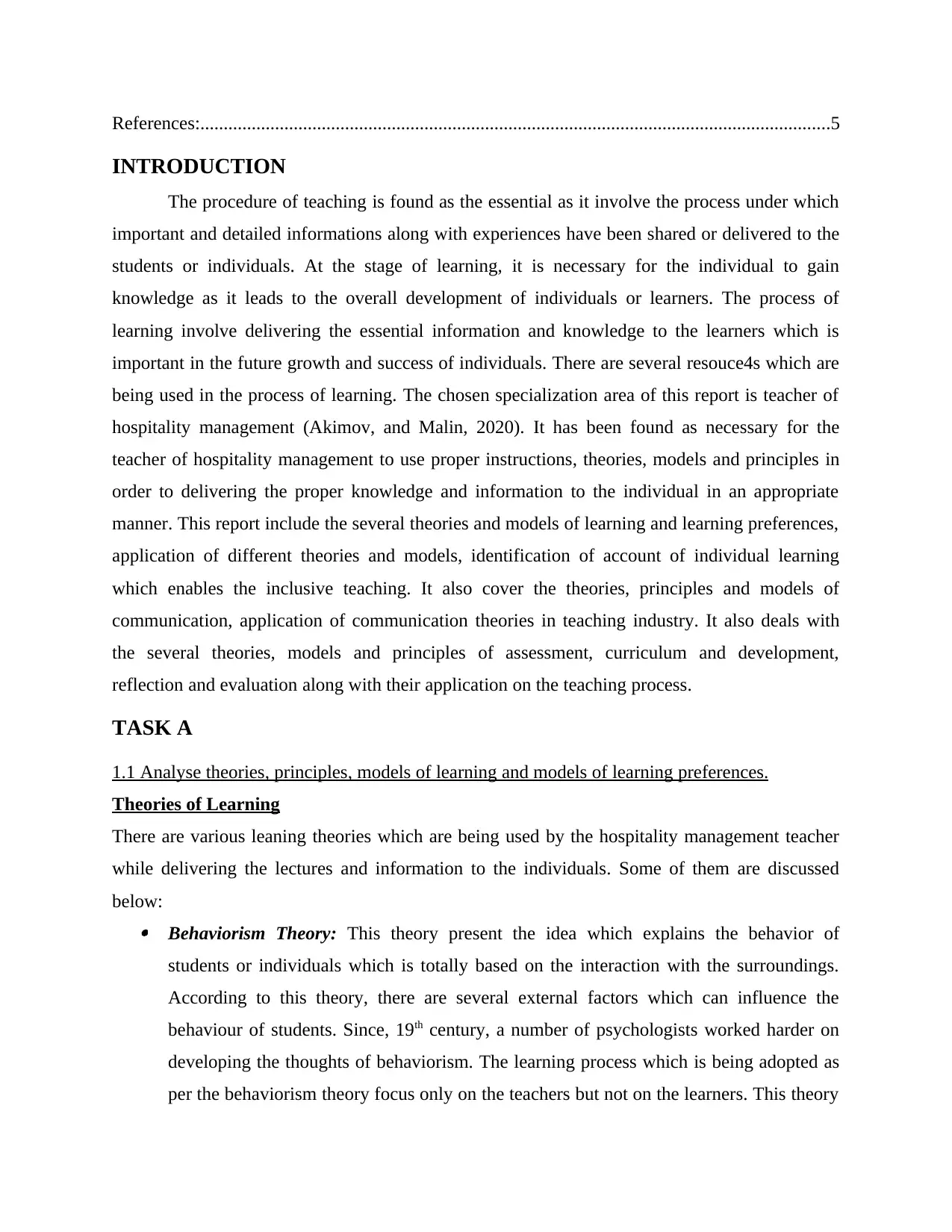
References:.......................................................................................................................................5
INTRODUCTION
The procedure of teaching is found as the essential as it involve the process under which
important and detailed informations along with experiences have been shared or delivered to the
students or individuals. At the stage of learning, it is necessary for the individual to gain
knowledge as it leads to the overall development of individuals or learners. The process of
learning involve delivering the essential information and knowledge to the learners which is
important in the future growth and success of individuals. There are several resouce4s which are
being used in the process of learning. The chosen specialization area of this report is teacher of
hospitality management (Akimov, and Malin, 2020). It has been found as necessary for the
teacher of hospitality management to use proper instructions, theories, models and principles in
order to delivering the proper knowledge and information to the individual in an appropriate
manner. This report include the several theories and models of learning and learning preferences,
application of different theories and models, identification of account of individual learning
which enables the inclusive teaching. It also cover the theories, principles and models of
communication, application of communication theories in teaching industry. It also deals with
the several theories, models and principles of assessment, curriculum and development,
reflection and evaluation along with their application on the teaching process.
TASK A
1.1 Analyse theories, principles, models of learning and models of learning preferences.
Theories of Learning
There are various leaning theories which are being used by the hospitality management teacher
while delivering the lectures and information to the individuals. Some of them are discussed
below: Behaviorism Theory: This theory present the idea which explains the behavior of
students or individuals which is totally based on the interaction with the surroundings.
According to this theory, there are several external factors which can influence the
behaviour of students. Since, 19th century, a number of psychologists worked harder on
developing the thoughts of behaviorism. The learning process which is being adopted as
per the behaviorism theory focus only on the teachers but not on the learners. This theory
INTRODUCTION
The procedure of teaching is found as the essential as it involve the process under which
important and detailed informations along with experiences have been shared or delivered to the
students or individuals. At the stage of learning, it is necessary for the individual to gain
knowledge as it leads to the overall development of individuals or learners. The process of
learning involve delivering the essential information and knowledge to the learners which is
important in the future growth and success of individuals. There are several resouce4s which are
being used in the process of learning. The chosen specialization area of this report is teacher of
hospitality management (Akimov, and Malin, 2020). It has been found as necessary for the
teacher of hospitality management to use proper instructions, theories, models and principles in
order to delivering the proper knowledge and information to the individual in an appropriate
manner. This report include the several theories and models of learning and learning preferences,
application of different theories and models, identification of account of individual learning
which enables the inclusive teaching. It also cover the theories, principles and models of
communication, application of communication theories in teaching industry. It also deals with
the several theories, models and principles of assessment, curriculum and development,
reflection and evaluation along with their application on the teaching process.
TASK A
1.1 Analyse theories, principles, models of learning and models of learning preferences.
Theories of Learning
There are various leaning theories which are being used by the hospitality management teacher
while delivering the lectures and information to the individuals. Some of them are discussed
below: Behaviorism Theory: This theory present the idea which explains the behavior of
students or individuals which is totally based on the interaction with the surroundings.
According to this theory, there are several external factors which can influence the
behaviour of students. Since, 19th century, a number of psychologists worked harder on
developing the thoughts of behaviorism. The learning process which is being adopted as
per the behaviorism theory focus only on the teachers but not on the learners. This theory
⊘ This is a preview!⊘
Do you want full access?
Subscribe today to unlock all pages.

Trusted by 1+ million students worldwide
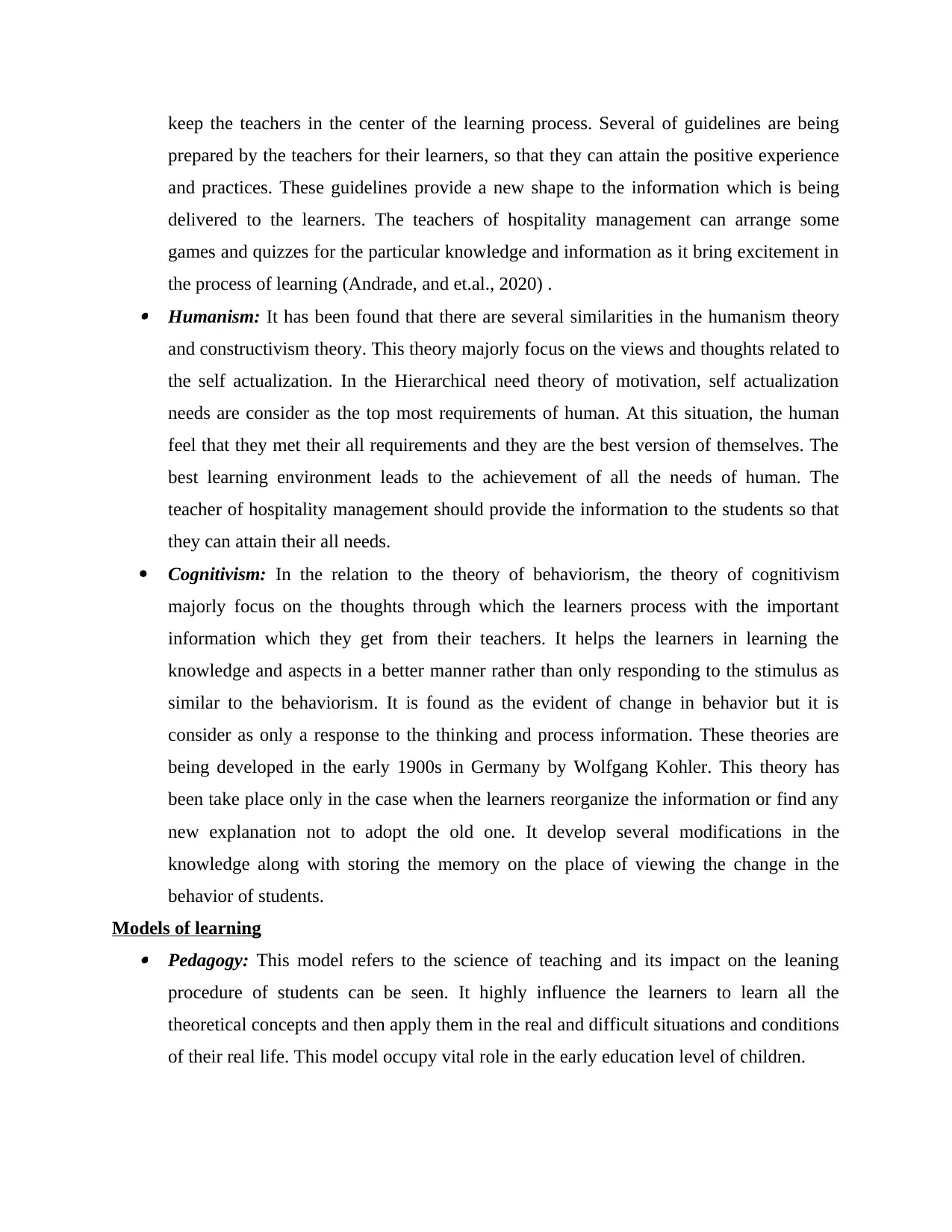
keep the teachers in the center of the learning process. Several of guidelines are being
prepared by the teachers for their learners, so that they can attain the positive experience
and practices. These guidelines provide a new shape to the information which is being
delivered to the learners. The teachers of hospitality management can arrange some
games and quizzes for the particular knowledge and information as it bring excitement in
the process of learning (Andrade, and et.al., 2020) . Humanism: It has been found that there are several similarities in the humanism theory
and constructivism theory. This theory majorly focus on the views and thoughts related to
the self actualization. In the Hierarchical need theory of motivation, self actualization
needs are consider as the top most requirements of human. At this situation, the human
feel that they met their all requirements and they are the best version of themselves. The
best learning environment leads to the achievement of all the needs of human. The
teacher of hospitality management should provide the information to the students so that
they can attain their all needs.
Cognitivism: In the relation to the theory of behaviorism, the theory of cognitivism
majorly focus on the thoughts through which the learners process with the important
information which they get from their teachers. It helps the learners in learning the
knowledge and aspects in a better manner rather than only responding to the stimulus as
similar to the behaviorism. It is found as the evident of change in behavior but it is
consider as only a response to the thinking and process information. These theories are
being developed in the early 1900s in Germany by Wolfgang Kohler. This theory has
been take place only in the case when the learners reorganize the information or find any
new explanation not to adopt the old one. It develop several modifications in the
knowledge along with storing the memory on the place of viewing the change in the
behavior of students.
Models of learning Pedagogy: This model refers to the science of teaching and its impact on the leaning
procedure of students can be seen. It highly influence the learners to learn all the
theoretical concepts and then apply them in the real and difficult situations and conditions
of their real life. This model occupy vital role in the early education level of children.
prepared by the teachers for their learners, so that they can attain the positive experience
and practices. These guidelines provide a new shape to the information which is being
delivered to the learners. The teachers of hospitality management can arrange some
games and quizzes for the particular knowledge and information as it bring excitement in
the process of learning (Andrade, and et.al., 2020) . Humanism: It has been found that there are several similarities in the humanism theory
and constructivism theory. This theory majorly focus on the views and thoughts related to
the self actualization. In the Hierarchical need theory of motivation, self actualization
needs are consider as the top most requirements of human. At this situation, the human
feel that they met their all requirements and they are the best version of themselves. The
best learning environment leads to the achievement of all the needs of human. The
teacher of hospitality management should provide the information to the students so that
they can attain their all needs.
Cognitivism: In the relation to the theory of behaviorism, the theory of cognitivism
majorly focus on the thoughts through which the learners process with the important
information which they get from their teachers. It helps the learners in learning the
knowledge and aspects in a better manner rather than only responding to the stimulus as
similar to the behaviorism. It is found as the evident of change in behavior but it is
consider as only a response to the thinking and process information. These theories are
being developed in the early 1900s in Germany by Wolfgang Kohler. This theory has
been take place only in the case when the learners reorganize the information or find any
new explanation not to adopt the old one. It develop several modifications in the
knowledge along with storing the memory on the place of viewing the change in the
behavior of students.
Models of learning Pedagogy: This model refers to the science of teaching and its impact on the leaning
procedure of students can be seen. It highly influence the learners to learn all the
theoretical concepts and then apply them in the real and difficult situations and conditions
of their real life. This model occupy vital role in the early education level of children.
Paraphrase This Document
Need a fresh take? Get an instant paraphrase of this document with our AI Paraphraser
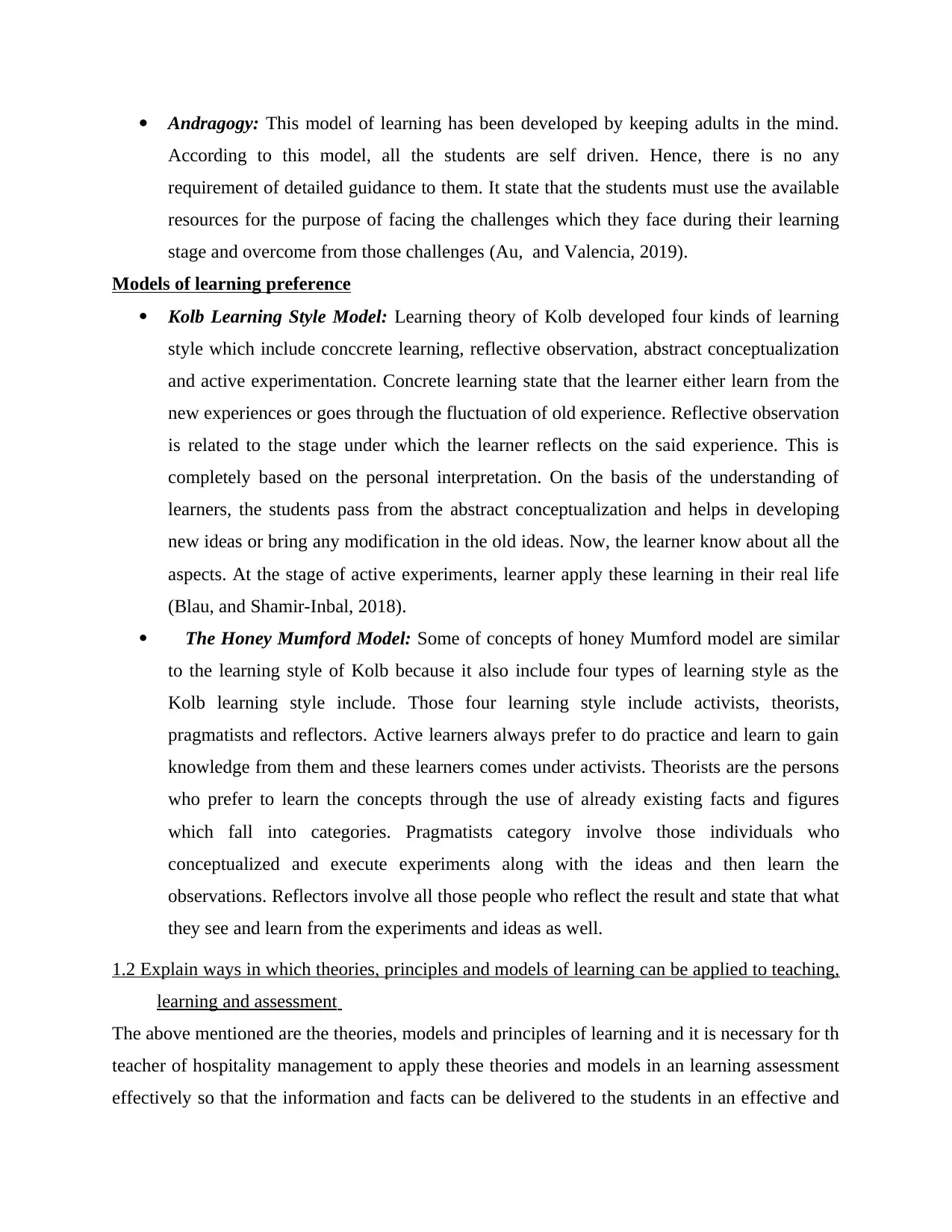
Andragogy: This model of learning has been developed by keeping adults in the mind.
According to this model, all the students are self driven. Hence, there is no any
requirement of detailed guidance to them. It state that the students must use the available
resources for the purpose of facing the challenges which they face during their learning
stage and overcome from those challenges (Au, and Valencia, 2019).
Models of learning preference
Kolb Learning Style Model: Learning theory of Kolb developed four kinds of learning
style which include conccrete learning, reflective observation, abstract conceptualization
and active experimentation. Concrete learning state that the learner either learn from the
new experiences or goes through the fluctuation of old experience. Reflective observation
is related to the stage under which the learner reflects on the said experience. This is
completely based on the personal interpretation. On the basis of the understanding of
learners, the students pass from the abstract conceptualization and helps in developing
new ideas or bring any modification in the old ideas. Now, the learner know about all the
aspects. At the stage of active experiments, learner apply these learning in their real life
(Blau, and Shamir-Inbal, 2018).
The Honey Mumford Model: Some of concepts of honey Mumford model are similar
to the learning style of Kolb because it also include four types of learning style as the
Kolb learning style include. Those four learning style include activists, theorists,
pragmatists and reflectors. Active learners always prefer to do practice and learn to gain
knowledge from them and these learners comes under activists. Theorists are the persons
who prefer to learn the concepts through the use of already existing facts and figures
which fall into categories. Pragmatists category involve those individuals who
conceptualized and execute experiments along with the ideas and then learn the
observations. Reflectors involve all those people who reflect the result and state that what
they see and learn from the experiments and ideas as well.
1.2 Explain ways in which theories, principles and models of learning can be applied to teaching,
learning and assessment
The above mentioned are the theories, models and principles of learning and it is necessary for th
teacher of hospitality management to apply these theories and models in an learning assessment
effectively so that the information and facts can be delivered to the students in an effective and
According to this model, all the students are self driven. Hence, there is no any
requirement of detailed guidance to them. It state that the students must use the available
resources for the purpose of facing the challenges which they face during their learning
stage and overcome from those challenges (Au, and Valencia, 2019).
Models of learning preference
Kolb Learning Style Model: Learning theory of Kolb developed four kinds of learning
style which include conccrete learning, reflective observation, abstract conceptualization
and active experimentation. Concrete learning state that the learner either learn from the
new experiences or goes through the fluctuation of old experience. Reflective observation
is related to the stage under which the learner reflects on the said experience. This is
completely based on the personal interpretation. On the basis of the understanding of
learners, the students pass from the abstract conceptualization and helps in developing
new ideas or bring any modification in the old ideas. Now, the learner know about all the
aspects. At the stage of active experiments, learner apply these learning in their real life
(Blau, and Shamir-Inbal, 2018).
The Honey Mumford Model: Some of concepts of honey Mumford model are similar
to the learning style of Kolb because it also include four types of learning style as the
Kolb learning style include. Those four learning style include activists, theorists,
pragmatists and reflectors. Active learners always prefer to do practice and learn to gain
knowledge from them and these learners comes under activists. Theorists are the persons
who prefer to learn the concepts through the use of already existing facts and figures
which fall into categories. Pragmatists category involve those individuals who
conceptualized and execute experiments along with the ideas and then learn the
observations. Reflectors involve all those people who reflect the result and state that what
they see and learn from the experiments and ideas as well.
1.2 Explain ways in which theories, principles and models of learning can be applied to teaching,
learning and assessment
The above mentioned are the theories, models and principles of learning and it is necessary for th
teacher of hospitality management to apply these theories and models in an learning assessment
effectively so that the information and facts can be delivered to the students in an effective and
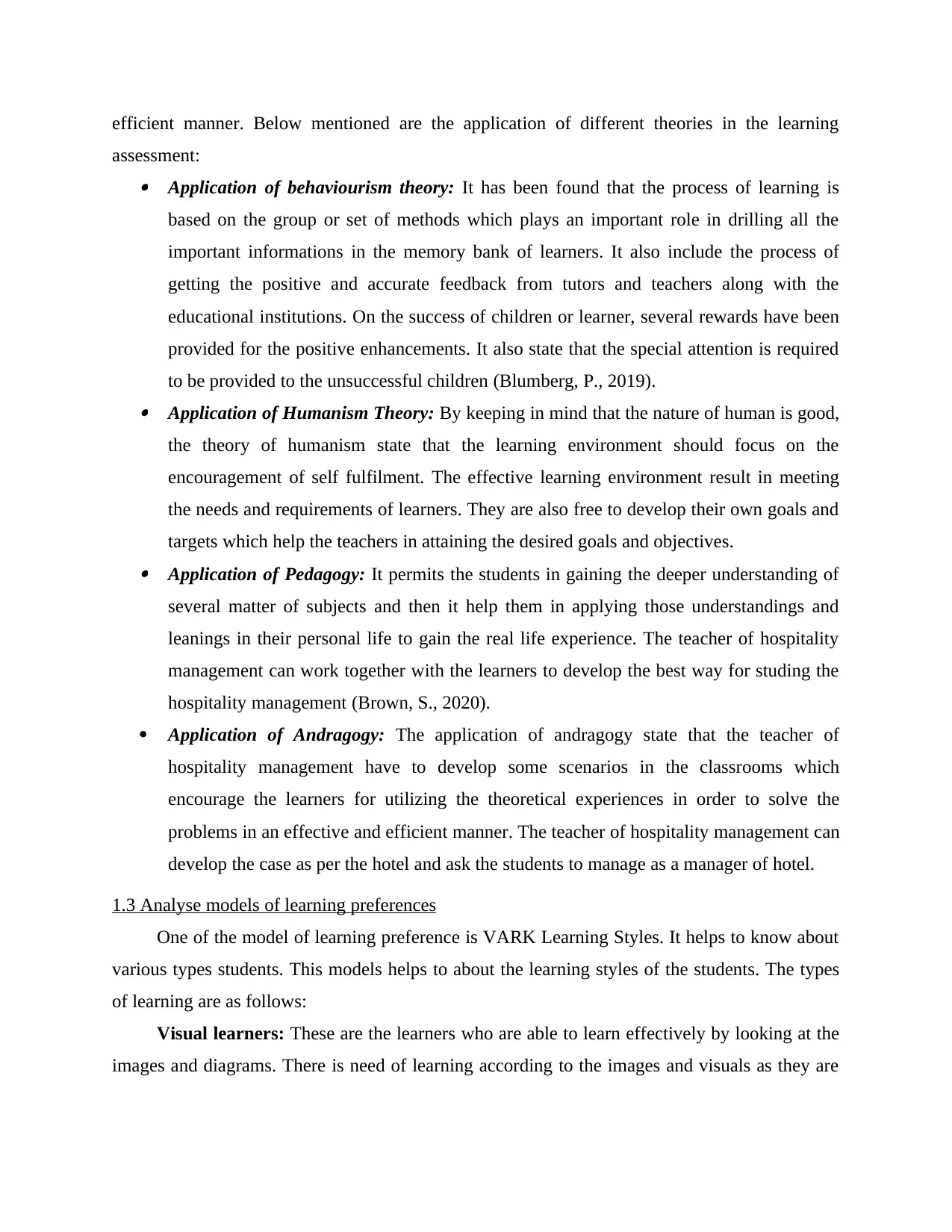
efficient manner. Below mentioned are the application of different theories in the learning
assessment: Application of behaviourism theory: It has been found that the process of learning is
based on the group or set of methods which plays an important role in drilling all the
important informations in the memory bank of learners. It also include the process of
getting the positive and accurate feedback from tutors and teachers along with the
educational institutions. On the success of children or learner, several rewards have been
provided for the positive enhancements. It also state that the special attention is required
to be provided to the unsuccessful children (Blumberg, P., 2019). Application of Humanism Theory: By keeping in mind that the nature of human is good,
the theory of humanism state that the learning environment should focus on the
encouragement of self fulfilment. The effective learning environment result in meeting
the needs and requirements of learners. They are also free to develop their own goals and
targets which help the teachers in attaining the desired goals and objectives. Application of Pedagogy: It permits the students in gaining the deeper understanding of
several matter of subjects and then it help them in applying those understandings and
leanings in their personal life to gain the real life experience. The teacher of hospitality
management can work together with the learners to develop the best way for studing the
hospitality management (Brown, S., 2020).
Application of Andragogy: The application of andragogy state that the teacher of
hospitality management have to develop some scenarios in the classrooms which
encourage the learners for utilizing the theoretical experiences in order to solve the
problems in an effective and efficient manner. The teacher of hospitality management can
develop the case as per the hotel and ask the students to manage as a manager of hotel.
1.3 Analyse models of learning preferences
One of the model of learning preference is VARK Learning Styles. It helps to know about
various types students. This models helps to about the learning styles of the students. The types
of learning are as follows:
Visual learners: These are the learners who are able to learn effectively by looking at the
images and diagrams. There is need of learning according to the images and visuals as they are
assessment: Application of behaviourism theory: It has been found that the process of learning is
based on the group or set of methods which plays an important role in drilling all the
important informations in the memory bank of learners. It also include the process of
getting the positive and accurate feedback from tutors and teachers along with the
educational institutions. On the success of children or learner, several rewards have been
provided for the positive enhancements. It also state that the special attention is required
to be provided to the unsuccessful children (Blumberg, P., 2019). Application of Humanism Theory: By keeping in mind that the nature of human is good,
the theory of humanism state that the learning environment should focus on the
encouragement of self fulfilment. The effective learning environment result in meeting
the needs and requirements of learners. They are also free to develop their own goals and
targets which help the teachers in attaining the desired goals and objectives. Application of Pedagogy: It permits the students in gaining the deeper understanding of
several matter of subjects and then it help them in applying those understandings and
leanings in their personal life to gain the real life experience. The teacher of hospitality
management can work together with the learners to develop the best way for studing the
hospitality management (Brown, S., 2020).
Application of Andragogy: The application of andragogy state that the teacher of
hospitality management have to develop some scenarios in the classrooms which
encourage the learners for utilizing the theoretical experiences in order to solve the
problems in an effective and efficient manner. The teacher of hospitality management can
develop the case as per the hotel and ask the students to manage as a manager of hotel.
1.3 Analyse models of learning preferences
One of the model of learning preference is VARK Learning Styles. It helps to know about
various types students. This models helps to about the learning styles of the students. The types
of learning are as follows:
Visual learners: These are the learners who are able to learn effectively by looking at the
images and diagrams. There is need of learning according to the images and visuals as they are
⊘ This is a preview!⊘
Do you want full access?
Subscribe today to unlock all pages.

Trusted by 1+ million students worldwide
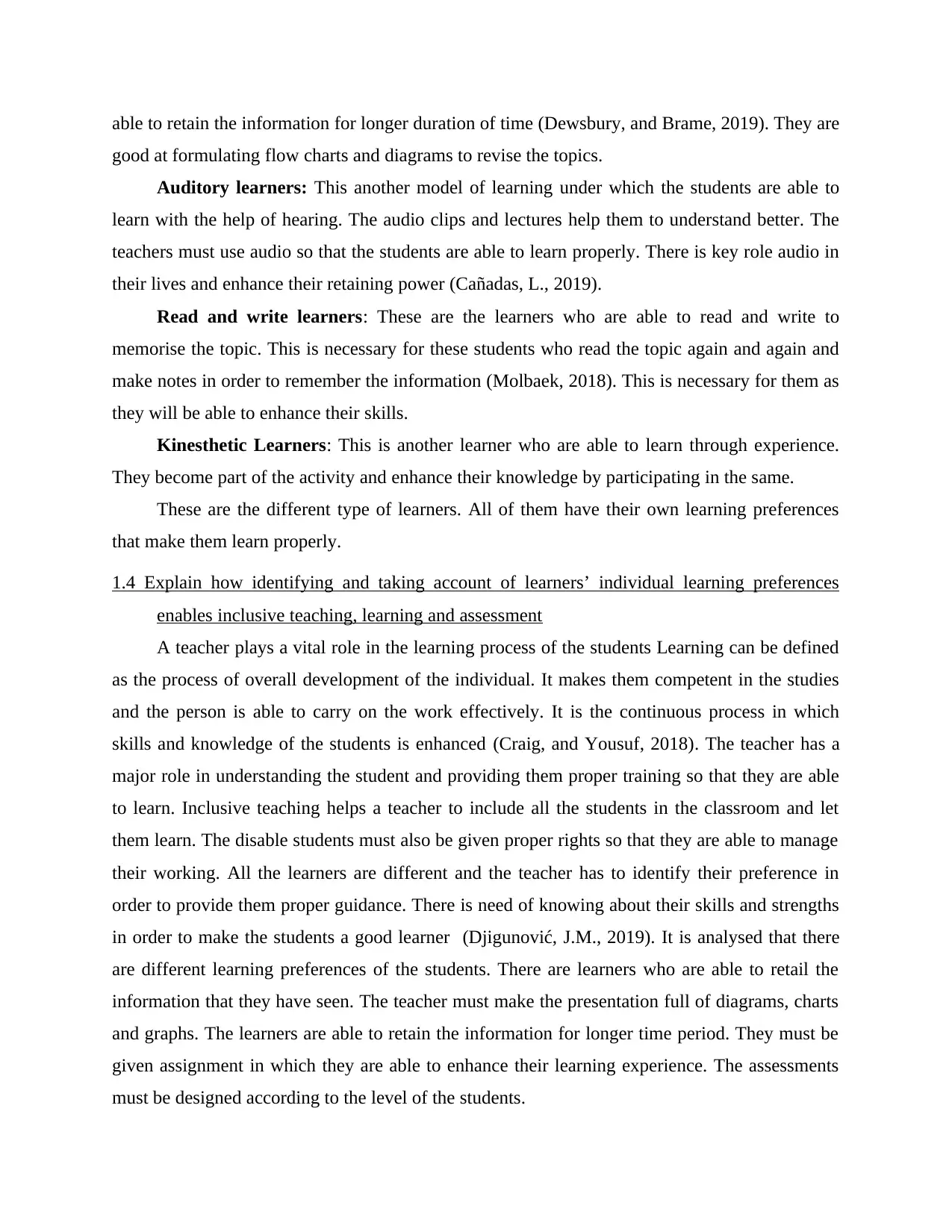
able to retain the information for longer duration of time (Dewsbury, and Brame, 2019). They are
good at formulating flow charts and diagrams to revise the topics.
Auditory learners: This another model of learning under which the students are able to
learn with the help of hearing. The audio clips and lectures help them to understand better. The
teachers must use audio so that the students are able to learn properly. There is key role audio in
their lives and enhance their retaining power (Cañadas, L., 2019).
Read and write learners: These are the learners who are able to read and write to
memorise the topic. This is necessary for these students who read the topic again and again and
make notes in order to remember the information (Molbaek, 2018). This is necessary for them as
they will be able to enhance their skills.
Kinesthetic Learners: This is another learner who are able to learn through experience.
They become part of the activity and enhance their knowledge by participating in the same.
These are the different type of learners. All of them have their own learning preferences
that make them learn properly.
1.4 Explain how identifying and taking account of learners’ individual learning preferences
enables inclusive teaching, learning and assessment
A teacher plays a vital role in the learning process of the students Learning can be defined
as the process of overall development of the individual. It makes them competent in the studies
and the person is able to carry on the work effectively. It is the continuous process in which
skills and knowledge of the students is enhanced (Craig, and Yousuf, 2018). The teacher has a
major role in understanding the student and providing them proper training so that they are able
to learn. Inclusive teaching helps a teacher to include all the students in the classroom and let
them learn. The disable students must also be given proper rights so that they are able to manage
their working. All the learners are different and the teacher has to identify their preference in
order to provide them proper guidance. There is need of knowing about their skills and strengths
in order to make the students a good learner (Djigunović, J.M., 2019). It is analysed that there
are different learning preferences of the students. There are learners who are able to retail the
information that they have seen. The teacher must make the presentation full of diagrams, charts
and graphs. The learners are able to retain the information for longer time period. They must be
given assignment in which they are able to enhance their learning experience. The assessments
must be designed according to the level of the students.
good at formulating flow charts and diagrams to revise the topics.
Auditory learners: This another model of learning under which the students are able to
learn with the help of hearing. The audio clips and lectures help them to understand better. The
teachers must use audio so that the students are able to learn properly. There is key role audio in
their lives and enhance their retaining power (Cañadas, L., 2019).
Read and write learners: These are the learners who are able to read and write to
memorise the topic. This is necessary for these students who read the topic again and again and
make notes in order to remember the information (Molbaek, 2018). This is necessary for them as
they will be able to enhance their skills.
Kinesthetic Learners: This is another learner who are able to learn through experience.
They become part of the activity and enhance their knowledge by participating in the same.
These are the different type of learners. All of them have their own learning preferences
that make them learn properly.
1.4 Explain how identifying and taking account of learners’ individual learning preferences
enables inclusive teaching, learning and assessment
A teacher plays a vital role in the learning process of the students Learning can be defined
as the process of overall development of the individual. It makes them competent in the studies
and the person is able to carry on the work effectively. It is the continuous process in which
skills and knowledge of the students is enhanced (Craig, and Yousuf, 2018). The teacher has a
major role in understanding the student and providing them proper training so that they are able
to learn. Inclusive teaching helps a teacher to include all the students in the classroom and let
them learn. The disable students must also be given proper rights so that they are able to manage
their working. All the learners are different and the teacher has to identify their preference in
order to provide them proper guidance. There is need of knowing about their skills and strengths
in order to make the students a good learner (Djigunović, J.M., 2019). It is analysed that there
are different learning preferences of the students. There are learners who are able to retail the
information that they have seen. The teacher must make the presentation full of diagrams, charts
and graphs. The learners are able to retain the information for longer time period. They must be
given assignment in which they are able to enhance their learning experience. The assessments
must be designed according to the level of the students.
Paraphrase This Document
Need a fresh take? Get an instant paraphrase of this document with our AI Paraphraser
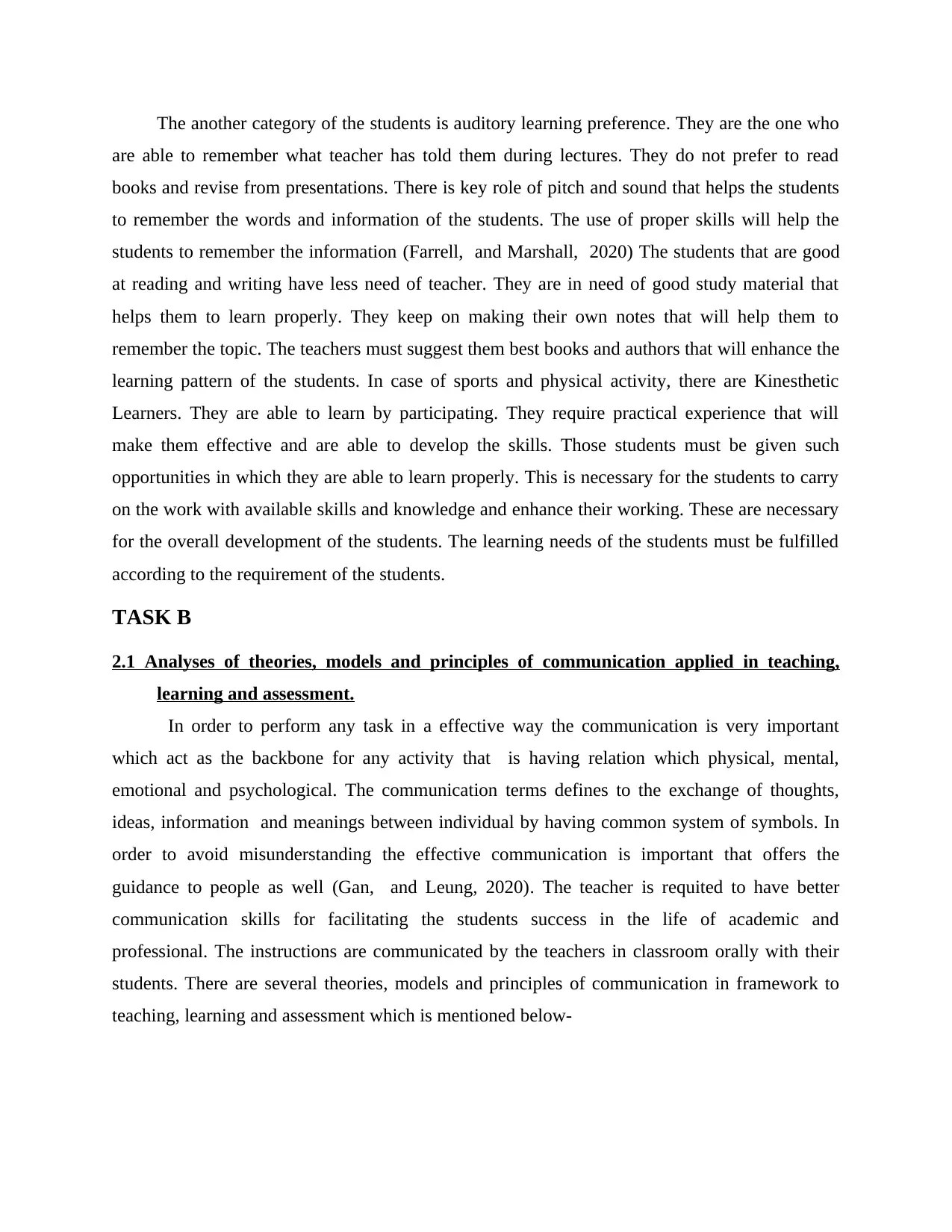
The another category of the students is auditory learning preference. They are the one who
are able to remember what teacher has told them during lectures. They do not prefer to read
books and revise from presentations. There is key role of pitch and sound that helps the students
to remember the words and information of the students. The use of proper skills will help the
students to remember the information (Farrell, and Marshall, 2020) The students that are good
at reading and writing have less need of teacher. They are in need of good study material that
helps them to learn properly. They keep on making their own notes that will help them to
remember the topic. The teachers must suggest them best books and authors that will enhance the
learning pattern of the students. In case of sports and physical activity, there are Kinesthetic
Learners. They are able to learn by participating. They require practical experience that will
make them effective and are able to develop the skills. Those students must be given such
opportunities in which they are able to learn properly. This is necessary for the students to carry
on the work with available skills and knowledge and enhance their working. These are necessary
for the overall development of the students. The learning needs of the students must be fulfilled
according to the requirement of the students.
TASK B
2.1 Analyses of theories, models and principles of communication applied in teaching,
learning and assessment.
In order to perform any task in a effective way the communication is very important
which act as the backbone for any activity that is having relation which physical, mental,
emotional and psychological. The communication terms defines to the exchange of thoughts,
ideas, information and meanings between individual by having common system of symbols. In
order to avoid misunderstanding the effective communication is important that offers the
guidance to people as well (Gan, and Leung, 2020). The teacher is requited to have better
communication skills for facilitating the students success in the life of academic and
professional. The instructions are communicated by the teachers in classroom orally with their
students. There are several theories, models and principles of communication in framework to
teaching, learning and assessment which is mentioned below-
are able to remember what teacher has told them during lectures. They do not prefer to read
books and revise from presentations. There is key role of pitch and sound that helps the students
to remember the words and information of the students. The use of proper skills will help the
students to remember the information (Farrell, and Marshall, 2020) The students that are good
at reading and writing have less need of teacher. They are in need of good study material that
helps them to learn properly. They keep on making their own notes that will help them to
remember the topic. The teachers must suggest them best books and authors that will enhance the
learning pattern of the students. In case of sports and physical activity, there are Kinesthetic
Learners. They are able to learn by participating. They require practical experience that will
make them effective and are able to develop the skills. Those students must be given such
opportunities in which they are able to learn properly. This is necessary for the students to carry
on the work with available skills and knowledge and enhance their working. These are necessary
for the overall development of the students. The learning needs of the students must be fulfilled
according to the requirement of the students.
TASK B
2.1 Analyses of theories, models and principles of communication applied in teaching,
learning and assessment.
In order to perform any task in a effective way the communication is very important
which act as the backbone for any activity that is having relation which physical, mental,
emotional and psychological. The communication terms defines to the exchange of thoughts,
ideas, information and meanings between individual by having common system of symbols. In
order to avoid misunderstanding the effective communication is important that offers the
guidance to people as well (Gan, and Leung, 2020). The teacher is requited to have better
communication skills for facilitating the students success in the life of academic and
professional. The instructions are communicated by the teachers in classroom orally with their
students. There are several theories, models and principles of communication in framework to
teaching, learning and assessment which is mentioned below-
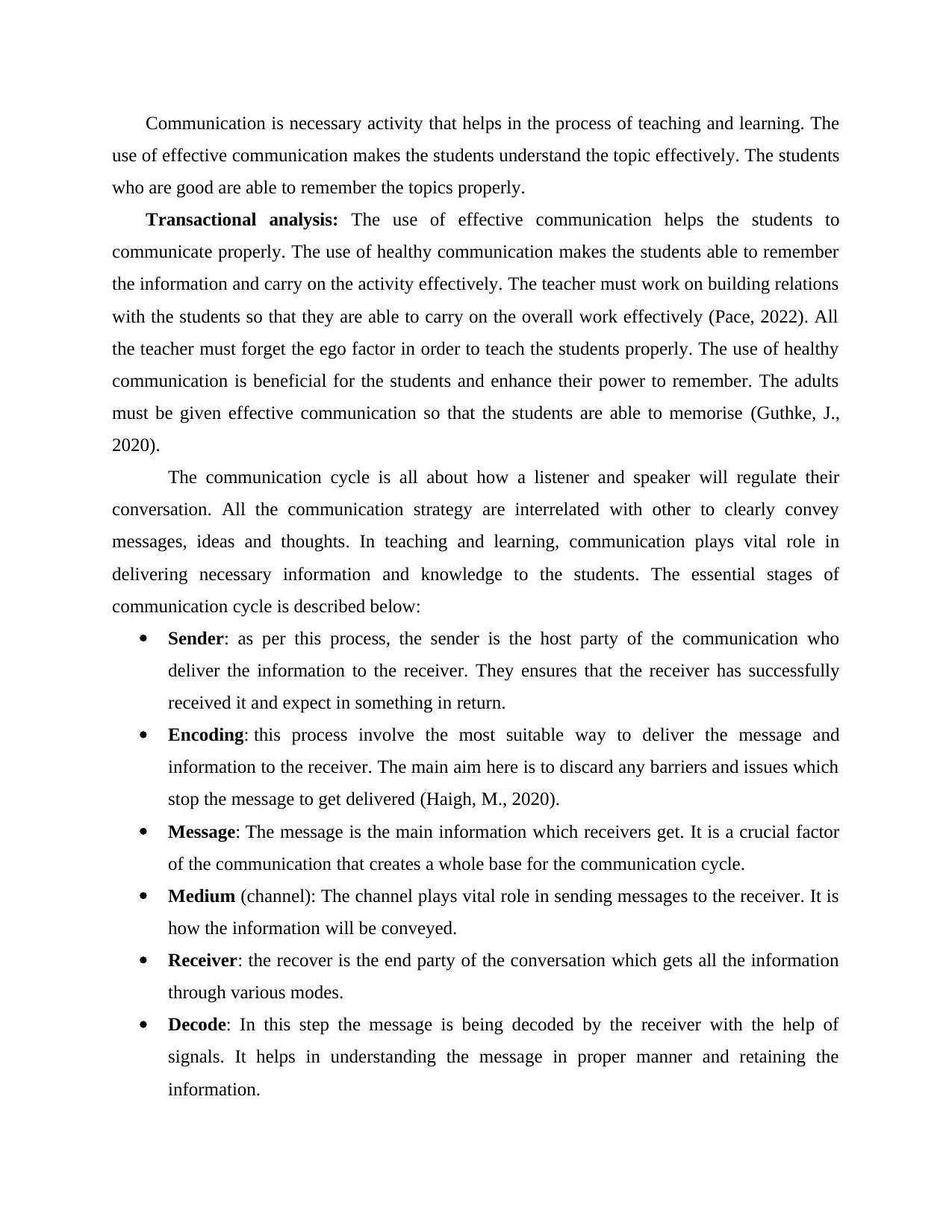
Communication is necessary activity that helps in the process of teaching and learning. The
use of effective communication makes the students understand the topic effectively. The students
who are good are able to remember the topics properly.
Transactional analysis: The use of effective communication helps the students to
communicate properly. The use of healthy communication makes the students able to remember
the information and carry on the activity effectively. The teacher must work on building relations
with the students so that they are able to carry on the overall work effectively (Pace, 2022). All
the teacher must forget the ego factor in order to teach the students properly. The use of healthy
communication is beneficial for the students and enhance their power to remember. The adults
must be given effective communication so that the students are able to memorise (Guthke, J.,
2020).
The communication cycle is all about how a listener and speaker will regulate their
conversation. All the communication strategy are interrelated with other to clearly convey
messages, ideas and thoughts. In teaching and learning, communication plays vital role in
delivering necessary information and knowledge to the students. The essential stages of
communication cycle is described below:
Sender: as per this process, the sender is the host party of the communication who
deliver the information to the receiver. They ensures that the receiver has successfully
received it and expect in something in return.
Encoding: this process involve the most suitable way to deliver the message and
information to the receiver. The main aim here is to discard any barriers and issues which
stop the message to get delivered (Haigh, M., 2020).
Message: The message is the main information which receivers get. It is a crucial factor
of the communication that creates a whole base for the communication cycle.
Medium (channel): The channel plays vital role in sending messages to the receiver. It is
how the information will be conveyed.
Receiver: the recover is the end party of the conversation which gets all the information
through various modes.
Decode: In this step the message is being decoded by the receiver with the help of
signals. It helps in understanding the message in proper manner and retaining the
information.
use of effective communication makes the students understand the topic effectively. The students
who are good are able to remember the topics properly.
Transactional analysis: The use of effective communication helps the students to
communicate properly. The use of healthy communication makes the students able to remember
the information and carry on the activity effectively. The teacher must work on building relations
with the students so that they are able to carry on the overall work effectively (Pace, 2022). All
the teacher must forget the ego factor in order to teach the students properly. The use of healthy
communication is beneficial for the students and enhance their power to remember. The adults
must be given effective communication so that the students are able to memorise (Guthke, J.,
2020).
The communication cycle is all about how a listener and speaker will regulate their
conversation. All the communication strategy are interrelated with other to clearly convey
messages, ideas and thoughts. In teaching and learning, communication plays vital role in
delivering necessary information and knowledge to the students. The essential stages of
communication cycle is described below:
Sender: as per this process, the sender is the host party of the communication who
deliver the information to the receiver. They ensures that the receiver has successfully
received it and expect in something in return.
Encoding: this process involve the most suitable way to deliver the message and
information to the receiver. The main aim here is to discard any barriers and issues which
stop the message to get delivered (Haigh, M., 2020).
Message: The message is the main information which receivers get. It is a crucial factor
of the communication that creates a whole base for the communication cycle.
Medium (channel): The channel plays vital role in sending messages to the receiver. It is
how the information will be conveyed.
Receiver: the recover is the end party of the conversation which gets all the information
through various modes.
Decode: In this step the message is being decoded by the receiver with the help of
signals. It helps in understanding the message in proper manner and retaining the
information.
⊘ This is a preview!⊘
Do you want full access?
Subscribe today to unlock all pages.

Trusted by 1+ million students worldwide
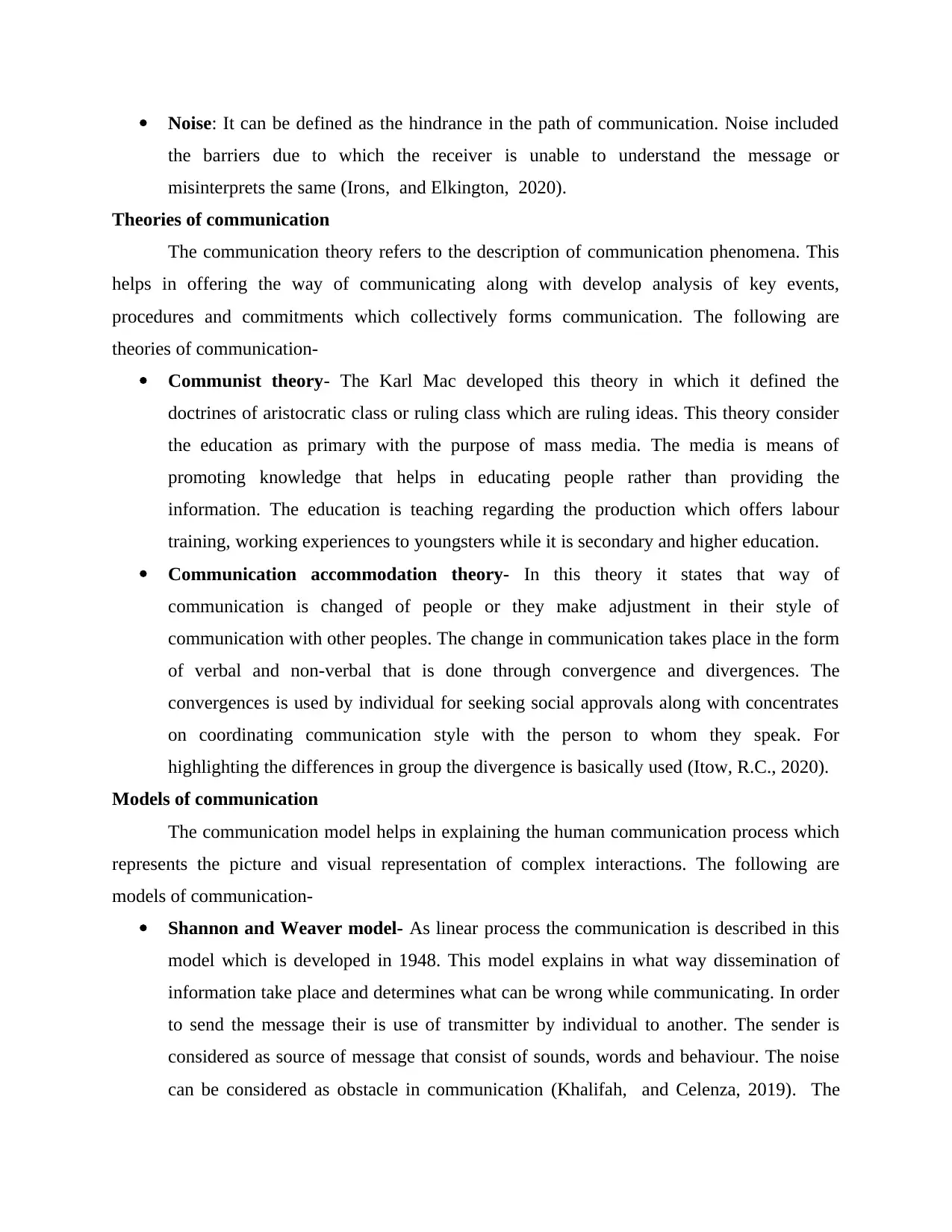
Noise: It can be defined as the hindrance in the path of communication. Noise included
the barriers due to which the receiver is unable to understand the message or
misinterprets the same (Irons, and Elkington, 2020).
Theories of communication
The communication theory refers to the description of communication phenomena. This
helps in offering the way of communicating along with develop analysis of key events,
procedures and commitments which collectively forms communication. The following are
theories of communication-
Communist theory- The Karl Mac developed this theory in which it defined the
doctrines of aristocratic class or ruling class which are ruling ideas. This theory consider
the education as primary with the purpose of mass media. The media is means of
promoting knowledge that helps in educating people rather than providing the
information. The education is teaching regarding the production which offers labour
training, working experiences to youngsters while it is secondary and higher education.
Communication accommodation theory- In this theory it states that way of
communication is changed of people or they make adjustment in their style of
communication with other peoples. The change in communication takes place in the form
of verbal and non-verbal that is done through convergence and divergences. The
convergences is used by individual for seeking social approvals along with concentrates
on coordinating communication style with the person to whom they speak. For
highlighting the differences in group the divergence is basically used (Itow, R.C., 2020).
Models of communication
The communication model helps in explaining the human communication process which
represents the picture and visual representation of complex interactions. The following are
models of communication-
Shannon and Weaver model- As linear process the communication is described in this
model which is developed in 1948. This model explains in what way dissemination of
information take place and determines what can be wrong while communicating. In order
to send the message their is use of transmitter by individual to another. The sender is
considered as source of message that consist of sounds, words and behaviour. The noise
can be considered as obstacle in communication (Khalifah, and Celenza, 2019). The
the barriers due to which the receiver is unable to understand the message or
misinterprets the same (Irons, and Elkington, 2020).
Theories of communication
The communication theory refers to the description of communication phenomena. This
helps in offering the way of communicating along with develop analysis of key events,
procedures and commitments which collectively forms communication. The following are
theories of communication-
Communist theory- The Karl Mac developed this theory in which it defined the
doctrines of aristocratic class or ruling class which are ruling ideas. This theory consider
the education as primary with the purpose of mass media. The media is means of
promoting knowledge that helps in educating people rather than providing the
information. The education is teaching regarding the production which offers labour
training, working experiences to youngsters while it is secondary and higher education.
Communication accommodation theory- In this theory it states that way of
communication is changed of people or they make adjustment in their style of
communication with other peoples. The change in communication takes place in the form
of verbal and non-verbal that is done through convergence and divergences. The
convergences is used by individual for seeking social approvals along with concentrates
on coordinating communication style with the person to whom they speak. For
highlighting the differences in group the divergence is basically used (Itow, R.C., 2020).
Models of communication
The communication model helps in explaining the human communication process which
represents the picture and visual representation of complex interactions. The following are
models of communication-
Shannon and Weaver model- As linear process the communication is described in this
model which is developed in 1948. This model explains in what way dissemination of
information take place and determines what can be wrong while communicating. In order
to send the message their is use of transmitter by individual to another. The sender is
considered as source of message that consist of sounds, words and behaviour. The noise
can be considered as obstacle in communication (Khalifah, and Celenza, 2019). The
Paraphrase This Document
Need a fresh take? Get an instant paraphrase of this document with our AI Paraphraser
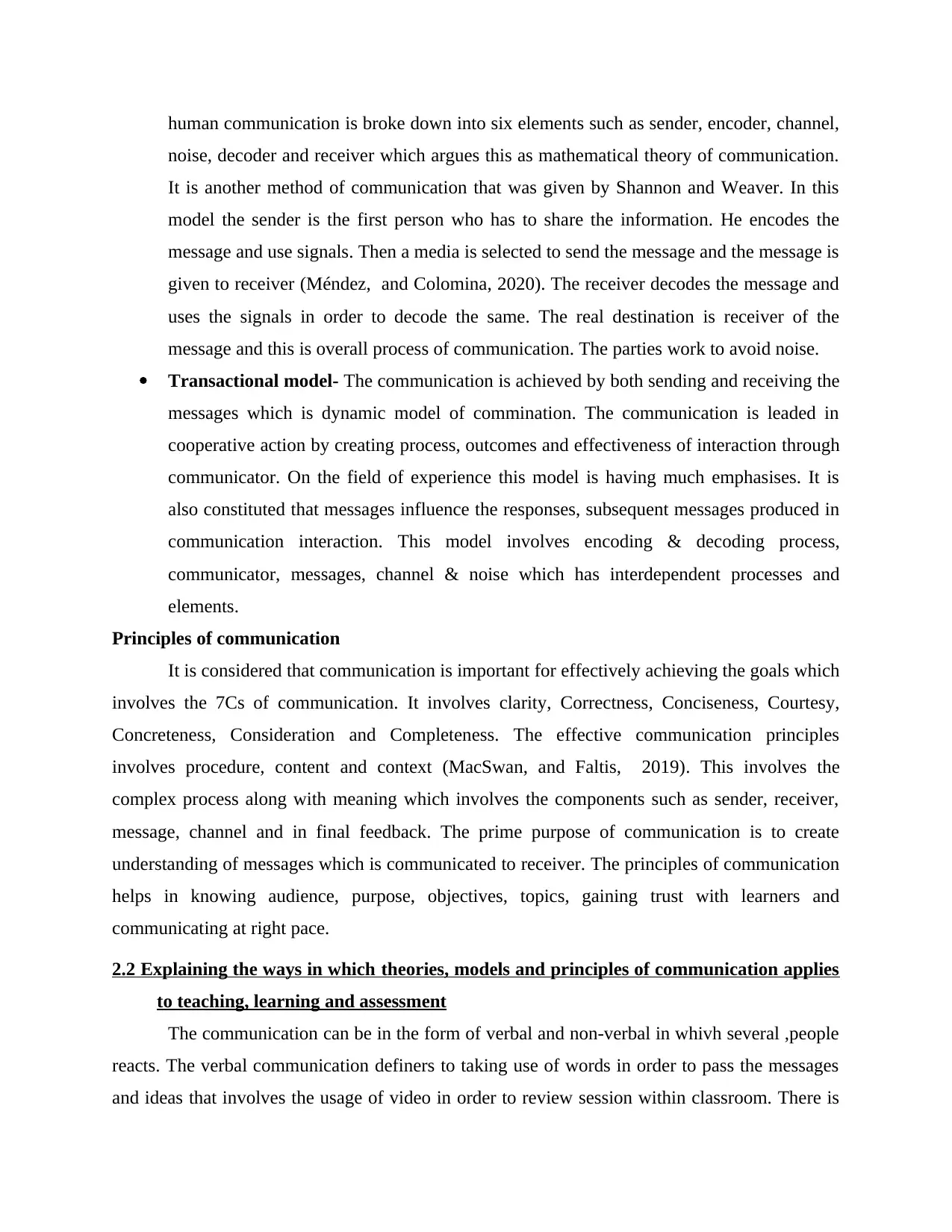
human communication is broke down into six elements such as sender, encoder, channel,
noise, decoder and receiver which argues this as mathematical theory of communication.
It is another method of communication that was given by Shannon and Weaver. In this
model the sender is the first person who has to share the information. He encodes the
message and use signals. Then a media is selected to send the message and the message is
given to receiver (Méndez, and Colomina, 2020). The receiver decodes the message and
uses the signals in order to decode the same. The real destination is receiver of the
message and this is overall process of communication. The parties work to avoid noise.
Transactional model- The communication is achieved by both sending and receiving the
messages which is dynamic model of commination. The communication is leaded in
cooperative action by creating process, outcomes and effectiveness of interaction through
communicator. On the field of experience this model is having much emphasises. It is
also constituted that messages influence the responses, subsequent messages produced in
communication interaction. This model involves encoding & decoding process,
communicator, messages, channel & noise which has interdependent processes and
elements.
Principles of communication
It is considered that communication is important for effectively achieving the goals which
involves the 7Cs of communication. It involves clarity, Correctness, Conciseness, Courtesy,
Concreteness, Consideration and Completeness. The effective communication principles
involves procedure, content and context (MacSwan, and Faltis, 2019). This involves the
complex process along with meaning which involves the components such as sender, receiver,
message, channel and in final feedback. The prime purpose of communication is to create
understanding of messages which is communicated to receiver. The principles of communication
helps in knowing audience, purpose, objectives, topics, gaining trust with learners and
communicating at right pace.
2.2 Explaining the ways in which theories, models and principles of communication applies
to teaching, learning and assessment
The communication can be in the form of verbal and non-verbal in whivh several ,people
reacts. The verbal communication definers to taking use of words in order to pass the messages
and ideas that involves the usage of video in order to review session within classroom. There is
noise, decoder and receiver which argues this as mathematical theory of communication.
It is another method of communication that was given by Shannon and Weaver. In this
model the sender is the first person who has to share the information. He encodes the
message and use signals. Then a media is selected to send the message and the message is
given to receiver (Méndez, and Colomina, 2020). The receiver decodes the message and
uses the signals in order to decode the same. The real destination is receiver of the
message and this is overall process of communication. The parties work to avoid noise.
Transactional model- The communication is achieved by both sending and receiving the
messages which is dynamic model of commination. The communication is leaded in
cooperative action by creating process, outcomes and effectiveness of interaction through
communicator. On the field of experience this model is having much emphasises. It is
also constituted that messages influence the responses, subsequent messages produced in
communication interaction. This model involves encoding & decoding process,
communicator, messages, channel & noise which has interdependent processes and
elements.
Principles of communication
It is considered that communication is important for effectively achieving the goals which
involves the 7Cs of communication. It involves clarity, Correctness, Conciseness, Courtesy,
Concreteness, Consideration and Completeness. The effective communication principles
involves procedure, content and context (MacSwan, and Faltis, 2019). This involves the
complex process along with meaning which involves the components such as sender, receiver,
message, channel and in final feedback. The prime purpose of communication is to create
understanding of messages which is communicated to receiver. The principles of communication
helps in knowing audience, purpose, objectives, topics, gaining trust with learners and
communicating at right pace.
2.2 Explaining the ways in which theories, models and principles of communication applies
to teaching, learning and assessment
The communication can be in the form of verbal and non-verbal in whivh several ,people
reacts. The verbal communication definers to taking use of words in order to pass the messages
and ideas that involves the usage of video in order to review session within classroom. There is
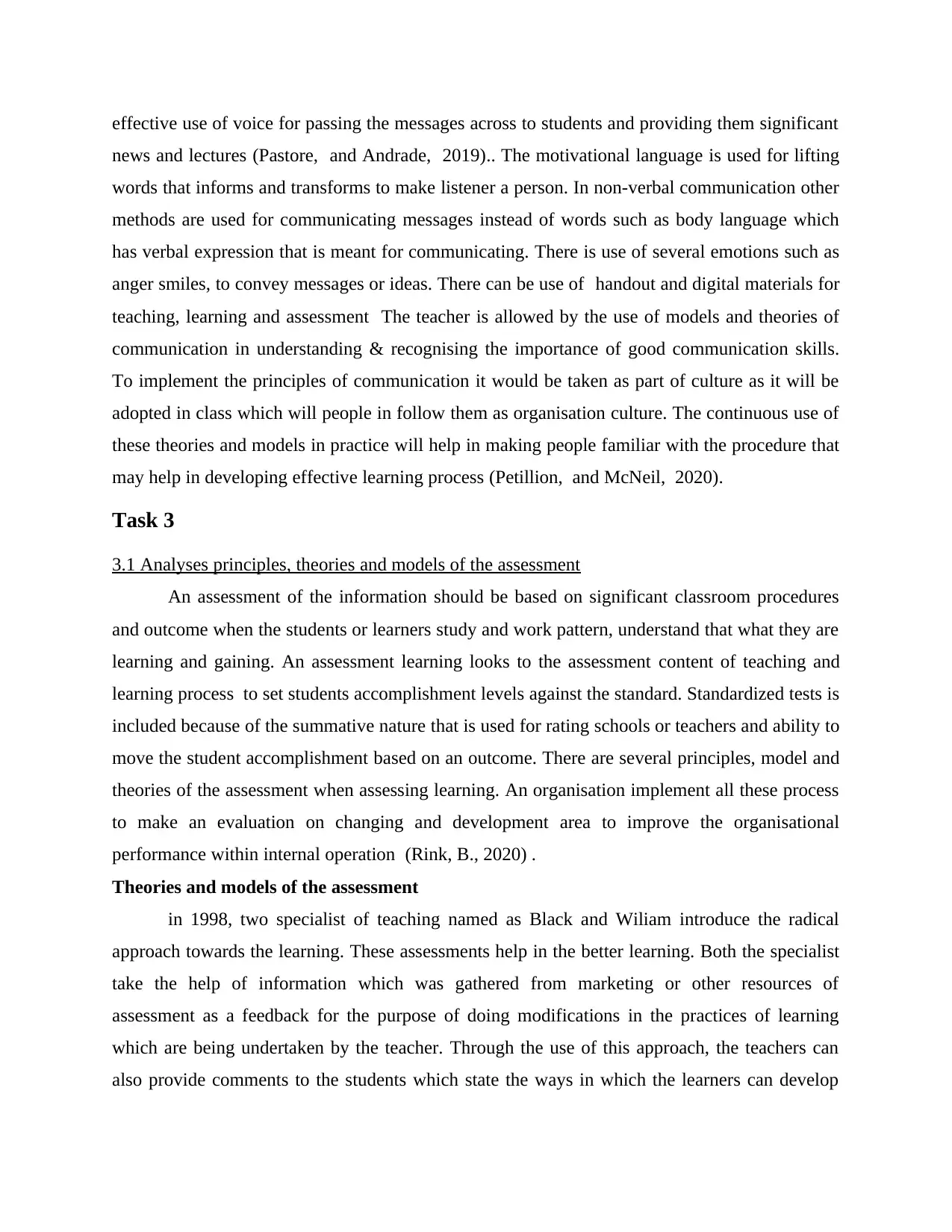
effective use of voice for passing the messages across to students and providing them significant
news and lectures (Pastore, and Andrade, 2019).. The motivational language is used for lifting
words that informs and transforms to make listener a person. In non-verbal communication other
methods are used for communicating messages instead of words such as body language which
has verbal expression that is meant for communicating. There is use of several emotions such as
anger smiles, to convey messages or ideas. There can be use of handout and digital materials for
teaching, learning and assessment The teacher is allowed by the use of models and theories of
communication in understanding & recognising the importance of good communication skills.
To implement the principles of communication it would be taken as part of culture as it will be
adopted in class which will people in follow them as organisation culture. The continuous use of
these theories and models in practice will help in making people familiar with the procedure that
may help in developing effective learning process (Petillion, and McNeil, 2020).
Task 3
3.1 Analyses principles, theories and models of the assessment
An assessment of the information should be based on significant classroom procedures
and outcome when the students or learners study and work pattern, understand that what they are
learning and gaining. An assessment learning looks to the assessment content of teaching and
learning process to set students accomplishment levels against the standard. Standardized tests is
included because of the summative nature that is used for rating schools or teachers and ability to
move the student accomplishment based on an outcome. There are several principles, model and
theories of the assessment when assessing learning. An organisation implement all these process
to make an evaluation on changing and development area to improve the organisational
performance within internal operation (Rink, B., 2020) .
Theories and models of the assessment
in 1998, two specialist of teaching named as Black and Wiliam introduce the radical
approach towards the learning. These assessments help in the better learning. Both the specialist
take the help of information which was gathered from marketing or other resources of
assessment as a feedback for the purpose of doing modifications in the practices of learning
which are being undertaken by the teacher. Through the use of this approach, the teachers can
also provide comments to the students which state the ways in which the learners can develop
news and lectures (Pastore, and Andrade, 2019).. The motivational language is used for lifting
words that informs and transforms to make listener a person. In non-verbal communication other
methods are used for communicating messages instead of words such as body language which
has verbal expression that is meant for communicating. There is use of several emotions such as
anger smiles, to convey messages or ideas. There can be use of handout and digital materials for
teaching, learning and assessment The teacher is allowed by the use of models and theories of
communication in understanding & recognising the importance of good communication skills.
To implement the principles of communication it would be taken as part of culture as it will be
adopted in class which will people in follow them as organisation culture. The continuous use of
these theories and models in practice will help in making people familiar with the procedure that
may help in developing effective learning process (Petillion, and McNeil, 2020).
Task 3
3.1 Analyses principles, theories and models of the assessment
An assessment of the information should be based on significant classroom procedures
and outcome when the students or learners study and work pattern, understand that what they are
learning and gaining. An assessment learning looks to the assessment content of teaching and
learning process to set students accomplishment levels against the standard. Standardized tests is
included because of the summative nature that is used for rating schools or teachers and ability to
move the student accomplishment based on an outcome. There are several principles, model and
theories of the assessment when assessing learning. An organisation implement all these process
to make an evaluation on changing and development area to improve the organisational
performance within internal operation (Rink, B., 2020) .
Theories and models of the assessment
in 1998, two specialist of teaching named as Black and Wiliam introduce the radical
approach towards the learning. These assessments help in the better learning. Both the specialist
take the help of information which was gathered from marketing or other resources of
assessment as a feedback for the purpose of doing modifications in the practices of learning
which are being undertaken by the teacher. Through the use of this approach, the teachers can
also provide comments to the students which state the ways in which the learners can develop
⊘ This is a preview!⊘
Do you want full access?
Subscribe today to unlock all pages.

Trusted by 1+ million students worldwide
1 out of 22
Related Documents
Your All-in-One AI-Powered Toolkit for Academic Success.
+13062052269
info@desklib.com
Available 24*7 on WhatsApp / Email
![[object Object]](/_next/static/media/star-bottom.7253800d.svg)
Unlock your academic potential
Copyright © 2020–2025 A2Z Services. All Rights Reserved. Developed and managed by ZUCOL.


